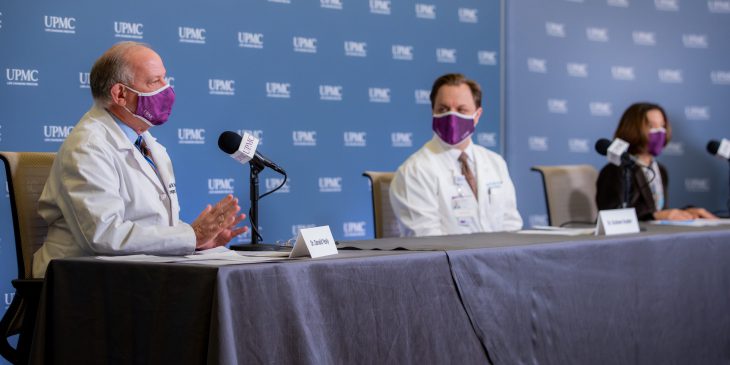A full year has passed since the start of the COVID-19 pandemic. UPMC’s senior medical director and chair of the Department of Emergency Medicine at UPMC and the University of Pittsburgh, Dr. Donald M. Yealy, reflected on some of the lessons learned over the past 12 months.
“By early February, we knew COVID-19 was going to be bigger than just China or Italy, but we didn’t know how big it would get or when it would come to us,” Yealy recalled. “I think health care professionals probably knew a month in advance that something major was going on, but the average person really didn’t know until it reached the U.S. or reached us here in western Pennsylvania.”
On Feb. 25, 2020, the Centers for Disease Control and Prevention announced COVID-19 was approaching pandemic status, and by March 11, it was officially labeled a pandemic by the World Health Organization. On March 13, former President Trump declared a national emergency and the country’s top medical experts advised a two-week shutdown to help “flatten the curve” of virus transmission.
Around this time, researchers at UPMC Clinical Laboratories worked quickly to develop a test for COVID-19, which could be administered using swabs designed and manufactured by the health system’s 3D Printing Program. Shortly after, UPMC’s first COVID-19 testing site opened in Pittsburgh’s South Side neighborhood.
Lesson One: Be prepared but expect additional surprises.
“What we’ve learned is that being prepared for public disasters is excellent — but it’s never enough,” said Yealy. “We should expect to be surprised even with preparations in place. It’s impossible to have everything we need set up from day one.”
In all the communities UPMC serves, COVID-19 cases were relatively low through the first half of 2020, but numbers drastically spiked in November and December. The ebb and flow of COVID-19 cases made constant communication with the public essential as guidance changed almost daily.
Lesson Two: Constant, clear and adaptable communication is key.
“You can never communicate enough. We’ve had to be clear and consistent, but also adaptable,” explained Yealy. “Some people want a single answer that never waivers, and it can be unnerving when that’s not possible. We have to say: Here’s the knowledge, here’s how it changed, and here’s why.”
To keep the public informed with the latest information on COVID-19, UPMC hosted more than 25 virtual media briefings where top UPMC medical experts and leadership shared clinical and health system updates.
Regarding clinical progress, research from UPMC and the University of Pittsburgh has contributed to a larger understanding of how to treat COVID-19 patients. With convalescent plasma, monoclonal antibody therapies and the introduction of vaccines against COVID-19, among other treatments, there is hope for an end to this pandemic on the horizon.
As vaccination expands to the general public, the goal is to see COVID-19 move from pandemic to endemic—meaning there will always be a constant presence of the disease within a specific geographic area, but it will be far less deadly.
“We’re close to the shift from pandemic to endemic, but we still have a few months more of masking, distancing, hand hygiene and not congregating,” said Yealy. “Even in the medical community where many of us are vaccinated, it’s not a free-for-all yet. We want to fully extinguish the fire before we can return to normal life. We all need to continue taking precautions to stay safe.”
Lesson Three: Continue to assess preparations for the future and prioritize vulnerable groups.
Moving forward, Yealy thinks it will be important to constantly assess preparations for major events like the COVID-19 pandemic, and to identify and prioritize the most vulnerable populations early on. “Our job is to recognize these patterns quickly and act upon them,” he said.
To stay up to date with the latest COVID-19 information from UPMC, visit upmc.com/media or follow @UPMCNews on Twitter.









